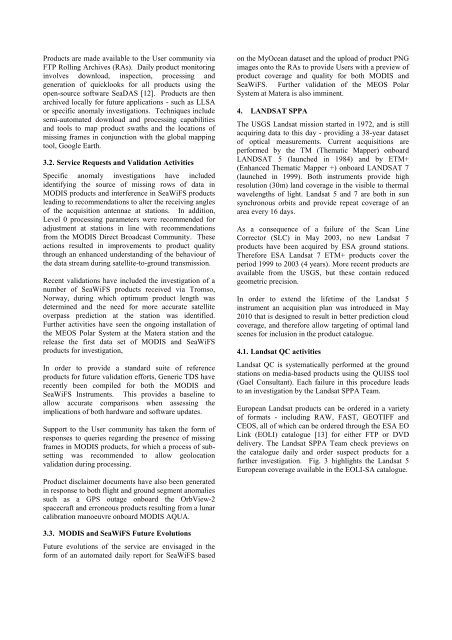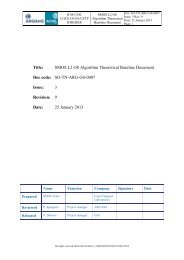Kent, C., Jackson, J., Borg, A., Sautreau, D - ARGANS
Kent, C., Jackson, J., Borg, A., Sautreau, D - ARGANS
Kent, C., Jackson, J., Borg, A., Sautreau, D - ARGANS
You also want an ePaper? Increase the reach of your titles
YUMPU automatically turns print PDFs into web optimized ePapers that Google loves.
Products are made available to the User community via<br />
FTP Rolling Archives (RAs). Daily product monitoring<br />
involves download, inspection, processing and<br />
generation of quicklooks for all products using the<br />
open-source software SeaDAS [12]. Products are then<br />
archived locally for future applications - such as LLSA<br />
or specific anomaly investigations. Techniques include<br />
semi-automated download and processing capabilities<br />
and tools to map product swaths and the locations of<br />
missing frames in conjunction with the global mapping<br />
tool, Google Earth.<br />
3.2. Service Requests and Validation Activities<br />
Specific anomaly investigations have included<br />
identifying the source of missing rows of data in<br />
MODIS products and interference in SeaWiFS products<br />
leading to recommendations to alter the receiving angles<br />
of the acquisition antennae at stations. In addition,<br />
Level 0 processing parameters were recommended for<br />
adjustment at stations in line with recommendations<br />
from the MODIS Direct Broadcast Community. These<br />
actions resulted in improvements to product quality<br />
through an enhanced understanding of the behaviour of<br />
the data stream during satellite-to-ground transmission.<br />
Recent validations have included the investigation of a<br />
number of SeaWiFS products received via Tromso,<br />
Norway, during which optimum product length was<br />
determined and the need for more accurate satellite<br />
overpass prediction at the station was identified.<br />
Further activities have seen the ongoing installation of<br />
the MEOS Polar System at the Matera station and the<br />
release the first data set of MODIS and SeaWiFS<br />
products for investigation,<br />
In order to provide a standard suite of reference<br />
products for future validation efforts, Generic TDS have<br />
recently been compiled for both the MODIS and<br />
SeaWiFS Instruments. This provides a baseline to<br />
allow accurate comparisons when assessing the<br />
implications of both hardware and software updates.<br />
Support to the User community has taken the form of<br />
responses to queries regarding the presence of missing<br />
frames in MODIS products, for which a process of subsetting<br />
was recommended to allow geolocation<br />
validation during processing.<br />
Product disclaimer documents have also been generated<br />
in response to both flight and ground segment anomalies<br />
such as a GPS outage onboard the OrbView-2<br />
spacecraft and erroneous products resulting from a lunar<br />
calibration manoeuvre onboard MODIS AQUA.<br />
3.3. MODIS and SeaWiFS Future Evolutions<br />
Future evolutions of the service are envisaged in the<br />
form of an automated daily report for SeaWiFS based<br />
on the MyOcean dataset and the upload of product PNG<br />
images onto the RAs to provide Users with a preview of<br />
product coverage and quality for both MODIS and<br />
SeaWiFS. Further validation of the MEOS Polar<br />
System at Matera is also imminent.<br />
4. LANDSAT SPPA<br />
The USGS Landsat mission started in 1972, and is still<br />
acquiring data to this day - providing a 38-year dataset<br />
of optical measurements. Current acquisitions are<br />
performed by the TM (Thematic Mapper) onboard<br />
LANDSAT 5 (launched in 1984) and by ETM+<br />
(Enhanced Thematic Mapper +) onboard LANDSAT 7<br />
(launched in 1999). Both instruments provide high<br />
resolution (30m) land coverage in the visible to thermal<br />
wavelengths of light. Landsat 5 and 7 are both in sun<br />
synchronous orbits and provide repeat coverage of an<br />
area every 16 days.<br />
As a consequence of a failure of the Scan Line<br />
Corrector (SLC) in May 2003, no new Landsat 7<br />
products have been acquired by ESA ground stations.<br />
Therefore ESA Landsat 7 ETM+ products cover the<br />
period 1999 to 2003 (4 years). More recent products are<br />
available from the USGS, but these contain reduced<br />
geometric precision.<br />
In order to extend the lifetime of the Landsat 5<br />
instrument an acquisition plan was introduced in May<br />
2010 that is designed to result in better prediction cloud<br />
coverage, and therefore allow targeting of optimal land<br />
scenes for inclusion in the product catalogue.<br />
4.1. Landsat QC activities<br />
Landsat QC is systematically performed at the ground<br />
stations on media-based products using the QUISS tool<br />
(Gael Consultant). Each failure in this procedure leads<br />
to an investigation by the Landsat SPPA Team.<br />
European Landsat products can be ordered in a variety<br />
of formats - including RAW, FAST, GEOTIFF and<br />
CEOS, all of which can be ordered through the ESA EO<br />
Link (EOLI) catalogue [13] for either FTP or DVD<br />
delivery. The Landsat SPPA Team check previews on<br />
the catalogue daily and order suspect products for a<br />
further investigation. Fig. 3 highlights the Landsat 5<br />
European coverage available in the EOLI-SA catalogue.



